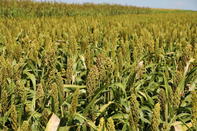Sorghum (Sorghum bicolor) is a gluten-free grain and is the fifth most commonly grown grain crop in the world behind wheat, rice, corn, and barley.

Sorghum is also known as Mabele thoro, Amazinba and Amabele. It is a tall growing grassy plant with flat leaves (like maize) and produces grains in a grass-like plume. There are now over 30 species but it probably originated in Ethiopia and spread into Africa and temperate regions of the world.
The cultivated sorghum's in South Africa are grown in the drier areas of the northern provinces in South Africa where it is planted between mid-October to mid-December. The Free State produces about 50% of South Africa’s sorghum. The average production yield of the grain’s seed is 2 ton/ha.
Uses of Sorghum
Sorghum is used for human consumption (cereal, flour, beer) and for animal feeding as silage or made into hay. Sorghum is also used for biodegradable packaging, wallboard, and for the production of baskets and brushes. The starch content of grain sorghum is 7 - 10% higher than maize, making it excellent for ethanol production. Ethanol is used as fuel.Eating Sorghum
Sorghum grains are milled into flour and used in porridge (such as ‘Maltabella’), unleavened bread, cookies, cakes, couscous and malted beverages. Eating the whole grain will ensure the most nutrition; soak in water overnight and boil as rice.
Sorghum is one of the best sources available for dietary fibre, it is high in protein, a good source of iron, phosphorus, magnesium, copper, calcium, zinc and potassium while the bran layer of sorghum has more antioxidants than blueberries, strawberries, and plums.
Sorghum as Animal Feed
As an animal feed, sorghum is used as an energy source for poultry, pigs, and ruminants - cattle, sheep etc. The grains have to be processed before being fed to animals - to make it easier to digest it can be milled, crushed and steamed before using it.
Sorghum serves as an important summer fodder - for silage or for hay when grown under irrigation in dry areas.
The stalks remaining after harvest can be grazed as some varieties stay green for a long period of time. The highest dry-matter yields of sorghum are obtained at maturity or when the stems are 80 to 120 cm tall. Such heights are suitable for hay, silage and green chop and are best grazed at 20 to 30 cm height.
By Marinda Louw